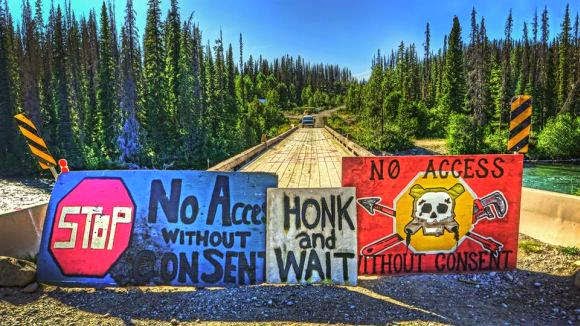nacimiento. Por lo tanto, Michelle y yo pasamos los últimos dos días buscando
la cabecera de cuenca del río Colorado entre el frío y la nieve que se
encuentran arriba de la zona de La Poudre Pass, al norte del Parque Nacional de
las Montañas Rocosas. El acceso se hace por la carretera Long Draw, que sale de
la autopista 14 de Colorado. La carretera Long Draw es un camino serpenteante
de terracería lleno de baches que atraviesa 22 km de bosques de pinos y abetos
y pasa por el reservorio Long Draw antes de terminar abruptamente en una
llanura de sauces.
Descubrimos que la carretera estaba cubierta con una pulgada de lodo escarchado
que requería que manejáramos a velocidades bajas para evitar resbalar y caer en
las zanjas de la carretera. El trayecto del viaje nos sirvió como periodo de
preparación para entender mejor el lugar de nacimiento del río Colorado. La
aspereza e incesantes baches de la carretera, combinados con las temperaturas
bajo cero, nos hacían cuestionarnos si realmente tomábamos en serio la visita a
la cabecera de cuenca del río Colorado. Me preocupaba que la Toyota Previa 1991
de Michelle no fuera capaz de soportar el camino, pero la camioneta cumplió las
expectativas que le permitieron lograr ser objeto de culto.
El trayecto de Long Draw pronosticó la violencia que encontraríamos en la
cabecera del río. Enormes extensiones de bosques talados por completo
flanquearon la carretera hasta llegar al desfiladero. El servicio forestal ha
de ser demasiado perezoso al quitar árboles porque, conforme colapsaban,
dejaron algunos de ellos en la carretera; los empleados del servicio forestal
sencillamente talaron con sierras de cadena, a 50 m de ambos lados de la
carretera, cada árbol que encontraron a su paso. A 5 km del final del camino,
nos topamos con una larga represa de poca altura que retenía la escorrentía de
montaña en el reservorio de Long Draw. Teníamos la expectativa de encontrar un
entorno silvestre en La Poudre Pass, por lo que al llegar a la represa fue como
toparse con una pared en la obscuridad.
Las extensiones deforestadas, la represa y el reservorio que encontramos son
lesiones penosas, pero ninguna de ellas es tan mala como la Grand Ditch (Gran
Zanja). Caminamos 400 m desde el final del Long Draw, donde encontramos una
señal que marcaba el lugar de la cabecera del río. De camino a la señal,
pasamos una zanja de 10 m de profundidad y otros 10 m de ancho, la cual llevaba
el agua de oeste a este. Estábamos en el lado oeste de la división continental
donde el agua fluye naturalmente hacia el oeste. Contemplamos la magia negra
empleada por los ingenieros para lograr esta proeza. La zanja en La Poudre Pass
era tan llamativa como una cicatriz profunda a medio rostro de un humano.
La Gran Zanja se inició a finales de la década de 1880 y fue excavada en su
mayor parte por un batallón de japoneses armados con herramientas manuales y
pólvora. Se construyó para sacar el agua, desviándola de la cabecera del río
Colorado a las ciudades en desarrollo al este de la cordillera Front de
Colorado. Cerca de 60 cm de profundidad de aguas rápidas corrían a través de la
zanja. Aprendimos que, incluso antes de que la nieve acumulada logre derretirse
y formar los pequeños arroyos reconocibles como los orígenes del río Colorado,
el agua le es robada al río. Parado en medio del polvo, me pregunto si el agua
almacenada aquí terminará en el campo de golf del Fuerte Collins o si las
vaquitas marinas la agitarán entre sus aletas nadando en el Golfo de California.
Si estudias el nacimiento del río Colorado aprenderás que sus aguas nacen del
vientre silvestre conformado por las nubes de los duros inviernos, las elevadas
cumbres montañosas y la acumulación de nieve. Sin embargo, estas aguas emergen
de este vientre directamente a la explotación. En La Poudre Pass, este río
recibe la primera manifestación de violencia que le seguirá durante el resto de
su vida.
Normal.dotm
0
0
1
581
3317
Tandem Productions
27
6
4073
12.0
0
false
18 pt
18 pt
0
0
false
false
false
/* Style Definitions */
table.MsoNormalTable
{mso-style-name:”Table Normal”;
mso-tstyle-rowband-size:0;
mso-tstyle-colband-size:0;
mso-style-noshow:yes;
mso-style-parent:””;
mso-padding-alt:0in 5.4pt 0in 5.4pt;
mso-para-margin:0in;
mso-para-margin-bottom:.0001pt;
mso-pagination:widow-orphan;
font-size:12.0pt;
font-family:”Times New Roman”;
mso-ascii-font-family:Cambria;
mso-ascii-theme-font:minor-latin;
mso-fareast-font-family:”Times New Roman”;
mso-fareast-theme-font:minor-fareast;
mso-hansi-font-family:Cambria;
mso-hansi-theme-font:minor-latin;}



